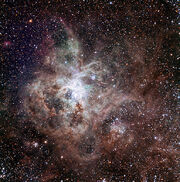
The Tarantula Nebula (also known as 30 Doradus, or NGC 2070) is an H II region in the Large Magellanic Cloud (LMC). It was originally thought to be a star, but in 1751 Nicolas Louis de Lacaille recognized its nebular nature.
The Tarantula Nebula has an apparent magnitude of 8. Considering its distance of about 49 kpc[2] (160,000 light years), this is an extremely luminous non-stellar object. Its luminosity is so great that if it were as close to Earth as the Orion Nebula, the Tarantula Nebula would cast shadows.[4] In fact, it is the most active starburst region known in the Local Group of galaxies. It is also the largest such region in the Local Group with an estimated diameter of 200 pc.[3] The nebula resides on the leading edge of the LMC, where ram pressure stripping, and the compression of the interstellar medium likely resulting from this, is at a maximum. At its core lies the compact star cluster R136 (approximate diameter 35 light years)[5] that produces most of the energy that makes the nebula visible. The estimated mass of the cluster is 450,000 solar masses, suggesting it will likely become a globular cluster in the future.[6]
In addition to R136, the Tarantula Nebula also contains an older star cluster – catalogued as Hodge 301 – with an age of 20–25 million years. The most massive stars of this cluster have already exploded in supernovae.[7]
The closest supernova observed since the invention of the telescope,[8] Supernova 1987A, occurred in the outskirts of the Tarantula Nebula.[9]
References
1. "SIMBAD Astronomical Database". Results for Tarantula Nebula. Retrieved 2006-12-22.
2. "SEDS Students for the Exploration and Development of Space". Results for Tarantula Nebula. Retrieved 2007-05-08. "30 Doradus .. 49 kpc +- 3 kpc"
3. Lebouteiller, V.; Bernard-Salas, J.; Brandl, B.; Whelan, D. G.; Wu, Yanling; Charmandaris, V.; Devost, D.; Houck, J. R. (June 2008). "Chemical Composition and Mixing in Giant H II Regions: NGC 3603, 30 Doradus, and N66". The Astrophysical Journal 680 (1): 398–419.
4. http://www.noao.edu/news/2011/pr1102.php
5. Massey, P ; Hunter, D. (January 1998). "Star Formation in R136: A Cluster of O3 Stars Revealed by Hubble Space Telescope Spectroscopy". The Astrophysical Journal 493 (1): 180.
6. Bosch, Guillermo; Terlevich, Elena; Terlevich, Roberto (2009). "Gemini/GMOS Search for Massive Binaries in the Ionizing Cluster of 30 Dor". Astronomical Journal 137 (2): 3437–3441.
7. Grebel, Eva K.; Chu, You-Hua (2000). "Hubble Space Telescope Photometry of Hodge 301: An "Old" Star Cluster in 30 Doradus". Astronomical Journal 119 (2): 787–799.
8. "Tarantula Nebula's Cosmic Web a Thing of Beauty". SPACE.com. 2011-03-21. Retrieved 2011-03-26.
9. "Encyclopedia of Space". Authors: Couper,Heather; Henbest, Nigel. Retrieved 2 January 2013.